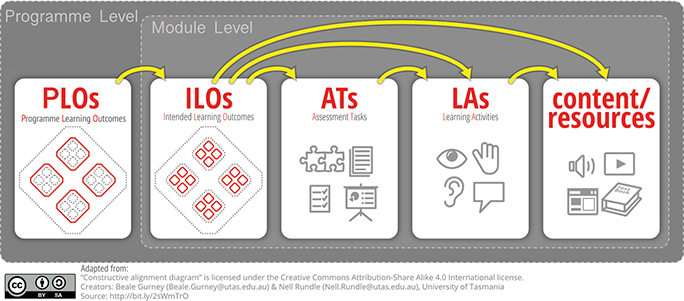Constructive alignment is predicated on the notion of developing an approach to programme design that is influenced by an outcomes-based teaching and learning model. The conceptualisation of constructive alignment was presented by John Biggs in his 1996 seminal paper and drew upon the work of constructivist learning theory and instructional design.
“Constructive alignment" represents a marriage of the two thrusts, constructivism being used as a framework to guide decision-making at all stages in instructional design” - (Biggs, 1996)
Its key proposal is that by defining effective and appropriate learning outcomes we can then use these to “align” the assessment tasks, learning resources and teaching activities within the programme thus ensuring all components of the programme are in support of students achieving the learning outcomes.
“In a good system, all aspects of teaching and assessment are tuned to support high level learning, so that all students are encouraged to use higher-order learning processes. 'Constructive alignment' (CA) is such a system. It is an approach to curriculum design that optimises the conditions for quality learning.” (Biggs, 2013)
Therefore, the learning activities, resources and tasks (e.g. formative or summative assessments) must be “aligned” to the learning outcomes so that we can be confident that by students undertaking these tasks they are being supported to be able to demonstrate their knowledge and ability in relation to the Learning outcomes.
“Good teaching is getting most students to use the higher cognitive level processes that the more academic students use spontaneously. Good teaching narrows the gap.” (Biggs, 1999, p. 58)

Figure 1 - Constructive alignment diagram, Beale Gurney & Nell Rundle, CC BY-SA
Back to: Centre for Innovation in Education
